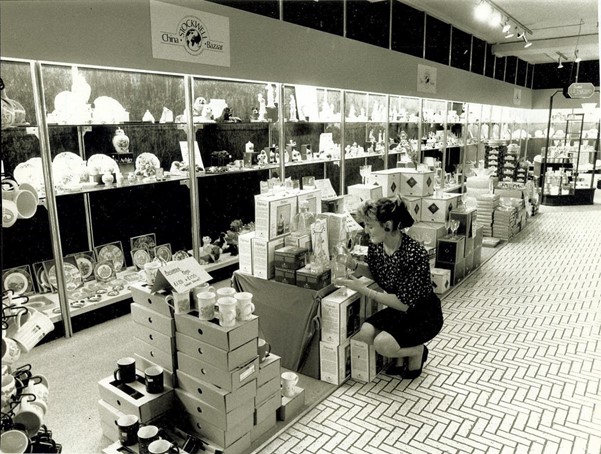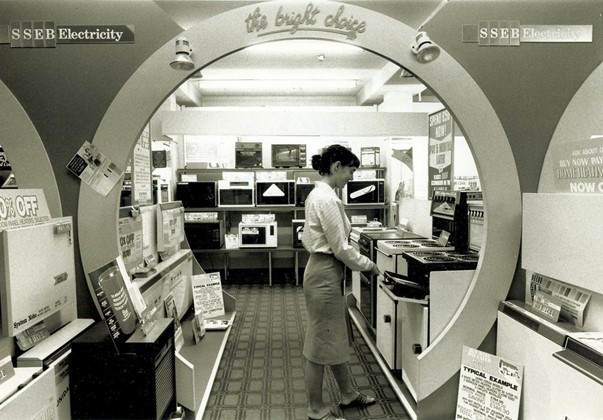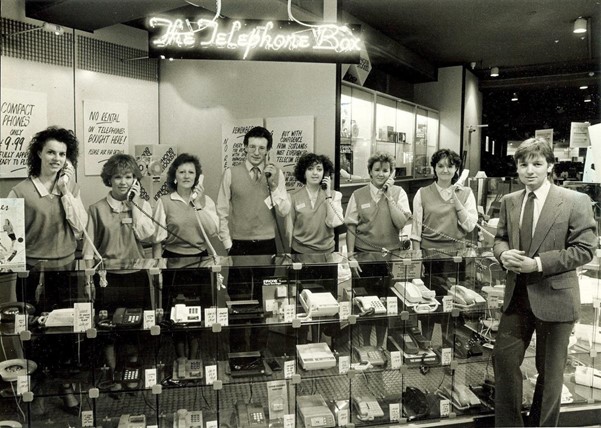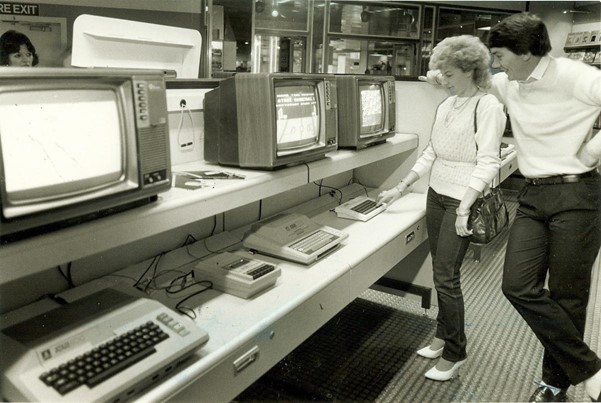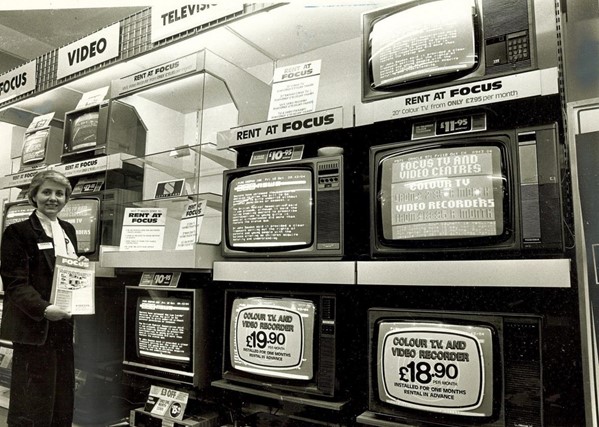Goldfish at Goldbergs
About Goldbergs
A. Goldberg and Sons plc, widely known simply as ‘Goldbergs’, was a Scottish retail organisation which, prior to its demise in 1990, had grown from a single Glasgow store in 1908 to a chain of over 100 outlets across the UK. In addition to Glasgow’s flagship Candleriggs store, Goldbergs’ Scottish outlets were located in Edinburgh, Falkirk, Ayr, Paisley, Kirkcaldy, Motherwell, Dundee, Kilmarnock, Airdrie, Dunfermline, East Kilbride and Greenock.
The company was at the forefront of technology and in the 1970s became the first retailer in Europe to introduce a comprehensive electronic point of sale (EPoS) system, which was an IBM system that was in place until 1987. This replaced the tradition of recording all sales transactions in day-books, an operation which involved having 500 bookkeepers. Goldbergs also developed its own in-house credit agreement, which was called the Style card. Launched in early 1982 and following the pattern of other credit cards, using the Style card incurred no interest if payments were promptly made on a monthly basis. Style card was eventually taken over by the Royal Bank of Scotland.
Sadly, Goldbergs went into receivership and ceased trading in 1990. The company’s Glasgow store was bought by entrepreneurs Vera and Gerald Weisfeld in 1994 and reopened as discount clothes store named ‘Weisfelds’ which was based on a similar concept to their previous business, ‘What Everyone Wants’.
Following the 1999 closure of Weisfeilds, the site became derelict and the building was partially demolished in 2002 after an adjacent tenement collapsed due to unstable foundations. The site was subsequently acquired by Selfridges, but plans for the company to build its first Scottish store on the site were shelved in 2007 and then abandoned in 2014 when the site was sold to a private developer.
Memories of Goldfish at Goldbergs
by Yvonne Alexis
A trip to Goldbergs in the centre of town was one of the year’s highlights. We were all scrubbed to within an inch of our lives, dressed in our best, which for me meant a smocked front dress made by Lindsay Maid, the company my aunties sewed for, to go shopping with mum, loaded up with a Provident Check, and later with a Style card, as we never had the resources to go and spend cash.
We travelled into town on the bus, sitting in the bottom deck on the long seats at the front that faced each other, although if an adult couldn’t get a seat we were whisked off by a look from mum, who wasn’t putting up with any nonsense. We were never allowed to go upstairs, a place which carried an air of mystery, although in hindsight, probably because this is where all the smokers went, and it stank. My mother was herself an inveterate smoker, but clearly even she didn’t want to smell as awful as upstairs on the bus was. We made faces at each other, sly punches and nips amongst us, kicks when we got the chance, although often caught by mum’s vigilant eye as she was constantly on the alert for anything that might bring shame upon her.
These visits usually took place in the weeks running up to Christmas, when mum would buy all our gifts, a fact we didn’t realise until very much later, believing absolutely in Santa Claus.

Yvonne Alexis far left, with Mum and siblings at Goldbergs. Courtesy of Yvonne Alexis
Me, mum, my two brothers and sister, off we trotted, to be mesmerised by the luxuriousness of the shop, its thick carpets, colourful and exciting window displays, and the massive aquarium full of goldfish – nothing else like it in town, or so we certainly thought. Dad was always working, so he couldn’t come, and the youngest left at home with auntie.
When we arrived, we would become suddenly shy, and had to be pushed in the big heavy glass doors by mum. We’d look around in awe at all the plush surroundings and glittering, fantastic decorations, and spent much of our time staring intensely at the vast aquarium full of goldfish and other exotica, until mum would entice us to leave by the promise of a visit to Santa.
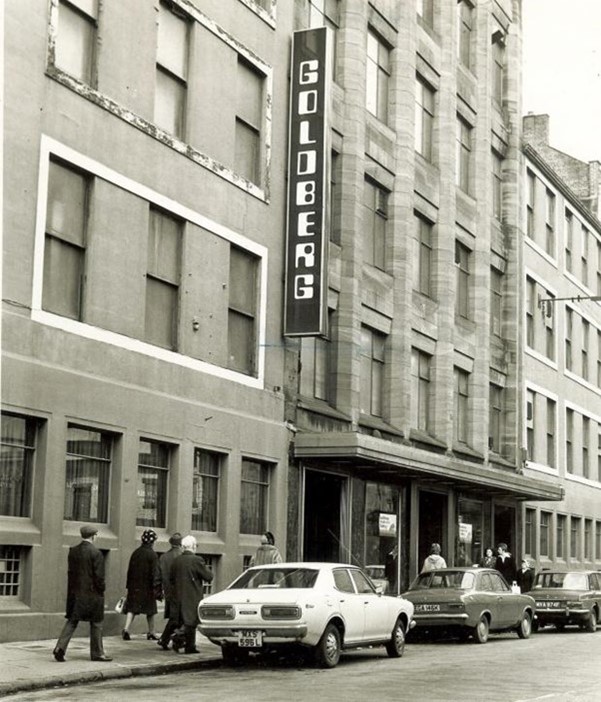
Of course, Santa was to be found on the floor that housed the toys, and what toys! Amazing train sets which were set up on a large wide table, fully landscaped with hills and small villages, train stations, station masters, cars and lorries awaiting the train, tiny people coming and going. The trains would rattle around the tracks, whistles blowing, carefully supervised by a young man keeping a close eye on all of us children. I am still desperate to have my own train set, although being a girl, this was not considered something appropriate for me at that time.
There were lavish dolls’ houses with so many rooms, with carpets and curtains and fancy furniture, little ornaments and lamps atop the sideboards and dressers. Separate bedrooms for everyone, big kitchens, dining rooms, sitting rooms. We lived in a room and kitchen with an outside toilet; such things were out of our ken, and we were mesmerised by the opulence of other lives.
There were porcelain dolls with painted faces and lacy dresses, hats and gloves, shiny shoes. There were toy soldiers with forts; guns and toy cars, some big enough to sit in and pedal, others tiny enough to fit in a matchbox. There were books with dress-up dolls, the clothes made of paper with little tabs to hang on to the doll’s frame. There were golliwogs, which have become much derided as time and attitudes have changed. Despite the fact that our father was Black, I have to say I never realised the significance of the golliwog back then, since it didn’t look like anyone I knew, with its stark black colouring and bright red and yellow outfits. We certainly had one or two at home when I was a child.
Our eyes darted everywhere, overwhelmed by the sight of all these treats, which we couldn’t possibly imagine ever having for ourselves. And thankfully, there were books, hundreds of books, my absolute favourite of all items in the shop. On my earlier visits I especially loved pop-up books. I could never understand how they managed to make a whole room with furniture and people appear like that, or an outside scene with cars and trains, what a miracle. Sometimes a heavenly scene too, all angels sitting on fluffy clouds, gazing adoringly down at us poor specimens. I moved on to ‘proper’ books – Jo of the Chalet School, lots of Enid Blyton, and other writers, about the lives of young people, usually middle and upper class (also now considered racist and classist), but these books were filled with adventure for me, adventures of a kind we would not be having. No messing about on the river for us, more like sailing little paper boats in puddles, wearing welly boots which left a ridge on our legs where our knee-high socks didn’t quite reach to protect them.
The grotto itself was magical to our young eyes. Santa’s helpers dressed like elves, keeping us in line and egging us on to tell Santa what we wanted, making sure no-one was left out and we were all kept on the go, no loitering. They were also there to direct us to the line for photographs, upselling they would call it today, and we’d have our picture taken in a little studio decorated to look like the inside of a bird’s cage or some other unlikely scene.
We didn’t get to spend the whole day gazing at toys. Mum would want to have a look at boring things like clothes, shoes, and houseware that she coveted. We’d trail at her back, whining because we wanted back to the toys, or to see again the beautiful goldfish swimming around. I can imagine now how she felt, having dragged my own children off to big stores when they were young, but at the time we just felt aggrieved by such unfairness, until, of course, if we were good, we got to the café, where we sat down to tea and cake for mum, ice-cream and lemonade for all of us. Amazingly excited by such treats, we’d for once sit still in case we were whisked away, as mum’s patience might completely run out.
Afterwards, we might get to have another excited visit to the toy floor; we’d take trips up and down the escalators, or run around on the deep-pile carpets which floored the whole store. We were wild, almost feral; mum would be chasing us around the place but trying to do so in a ladylike fashion, shouting in a whisper, too embarrassed to be seen and heard behaving ‘like a fishwife.’
By four o’clock it was time to leave. The city would be fully dark, the wet streets full of people scurrying home, lit up by the lights shining from shop windows out onto the dimly lit streets. Sometimes, there would be deep pea-souper fog, and we’d all walk very slowly, holding hands, a little fearful. We’d be tired, irritable and annoying each other, herded onto a bus where we’d have to stand because the workers were now on their way home, so standing room only. There would be tears from us and rows from mum, who was loaded down with shopping which she didn’t trust any of us with since we were so hyperactive and clumsy.
The bus would take forever to get home, and smelled of sweat and smoke, and the men would be dirty from their work, grumpy and not in the mood for somebody else’s annoying children. Despite this, a day at Goldbergs always left us feeling a glow of exhilaration and expectation, excited for Christmas coming, positive that Santa would not forget what we’d asked for. The cold and wet of the cramped buses and streets, would soon fade away in our memories, but the excitement and memory of our day out in beautiful Goldbergs lasted until well after Christmas, warming us through the dark winter weeks.
Inside Goldbergs’ Departments
